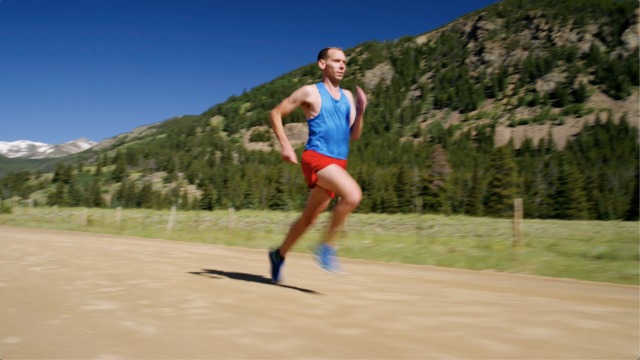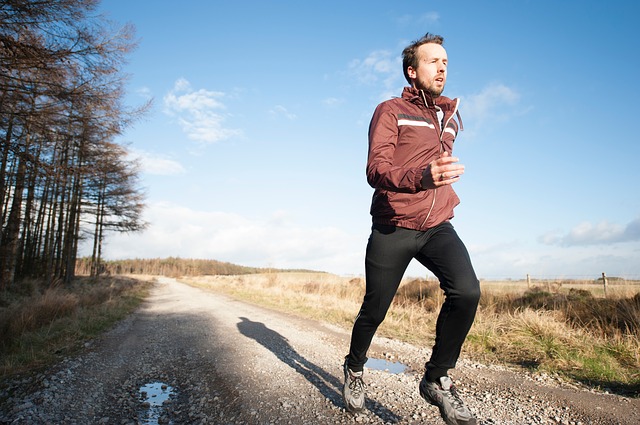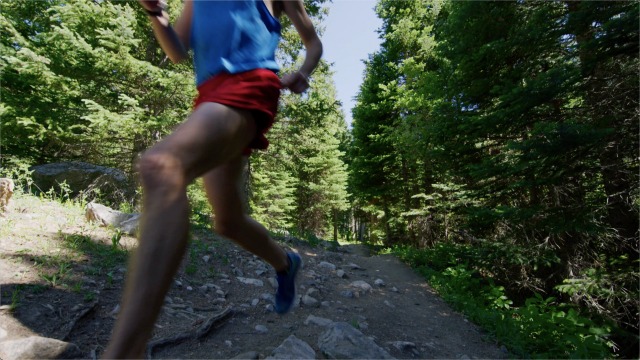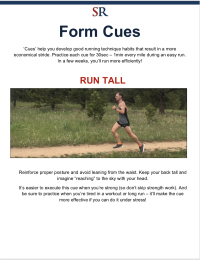In 2010, my obsession with running form peaked. I started caring about things that I never thought of before, like running cadence, foot strike, and how shoes impacted our form.

Working on my turnover in the mountains of Colorado
We can thank Christopher McDougall’s #1 best-selling book Born to Run for my obsession with running form.
He wove a convincing tale of superhuman endurance runners that lived secretively in the mountains of Mexico. They could run hundreds of miles on thin slices of rubber as shoes, with barely anything to eat, and without any formal training.
Oh, and they practically never got injured. Clearly, this piqued every runners’ interest and the book rocketed onto the bestseller lists for years.
And while the story is indeed mostly true, we need more context to truly understand form and running technique.
In this article, I want to focus on your running cadence – because this was focused on heavily in Born to Run and is a major aspect of good form.
In fact, I remember a quote from Caballo Blanco (a major character from the book) very clearly about cadence:
When deciding whether to take one or two steps between rocks, take three.
He meant that taking more steps would help runners navigate technical, rocky terrain. Longer, bounding steps are less efficient, require more energy, and aren’t as economical at covering most gnarly trails in the mountains.
Let’s learn more about running cadence, why it’s important, when you should attempt to change it, and why some runners should avoid modifying their form.
What is Running Cadence?

Running Cadence: Your Step Rate Per Minute
At its most simplest, cadence is your step rate per minute. The number of steps you take (on both legs) in one minute is your cadence.
You can find your cadence by counting how many times both feet hit the ground in one minute. But I find it easier to count how many steps one foot takes in a single minute and then doubling that to determine your cadence.
This analog, simple, and very basic method is superior to apps or devices that track your cadence because it’s 100% accurate. Let’s get a number we’re confident in!
Awhile back, the number 180 was popularized in Jack Daniels Running Formula (perhaps *the* OG training book). He discovered that elite athletes run with a cadence of 180 steps per minute or more.
Soon, everyone from Runner’s World to Chi Running to music websites (selling songs with beats at this cadence) were on the 180-cadence bandwagon.
But there’s nothing magical about this particular running cadence! In fact, cadence can vary dramatically based on a host of factors like:
- Terrain
- Individual biomechanics
- The height of the runner
- Speed (this is the most important)
And because cadence varies, it’s important to focus on it only when it really matters.
For more on this topic, be sure to listen to episode 296 of the Strength Running Podcast!
When is Cadence Important to Measure?
Since your running cadence can vary dramatically based on speed, there can’t be one single number that we focus on (it’s always changing depending on pace).
If you’re running at a relaxed, recovery effort your cadence might be 165 steps per minute. But if you’re sprinting or running a series of fast repetitions, your cadence might be 220 steps per minute!
Clearly, we need to measure our cadence at the right time if we’re to find a number that’s truly meaningful.
And that time is when we’re running at an easy, comfortable effort. Only during easy-paced runs is your cadence number relevant.
Since we run approximately 80% (or more) of our mileage at this easy pace, cadence is an important metric to understand because it impacts how economical we are for a majority of our mileage.
Just think: most of our training time is spent running easy. We must get this right to prevent injuries!
That makes it critical for preventing injuries because an ideal running cadence:
- Reduces impact forces traveling up the leg, helping make running less stressful
- Helps eliminate the aggressive, “heel smashing” variety of heel-striking
- Reduces over-striding, braking forces, and thus improves economy
A good running cadence delivers all of these injury prevention and efficiency benefits. So, if 180 steps per minute isn’t the gold standard, how do you know what your cadence should be?
It all depends on your easy pace.
What’s My Ideal Running Cadence?
Since we measure running cadence during an easy run – and it’s dependent on speed – your easy running pace is the foundation for figuring out your ideal step rate.
Rather than blindly pledge our allegiance to 180 steps per minute, we’re going to take a more nuanced view:
If your easy pace is slower than 10 minutes per mile, your cadence ought to be 160+ steps per minute.
If your easy pace is faster than 10 minutes per mile, your cadence ought to be 170+ steps per minute.
This simple “if, then” framework helps us better determine where our cadence should fall.
We also have a video overview of running cadence on Strength Running’s YouTube channel:
It’s also a spectrum, meaning that if you’re substantially faster than the 10min/mile threshold, your cadence will vary accordingly.
Here’s a good example from the faster end of this spectrum:
- An easy pace of 7:00 per mile will likely want a cadence closer to 180 steps per minute
- An easy pace of 9:30 per mile can be much closer to 170 steps per minute
Of course, many other factors affect your cadence like your height. Taller runners will naturally have slightly slower cadences.
The point here is to give you a new way of thinking about your running cadence. It’s a metric that varies widely and is more of an appropriate range rather than a single, specific number.
If you find that your step rate is substantially lower than the recommended ranges above, there are many things you can do to improve it.
How Can You Change Your Running Cadence?

Trail running can improve athleticism, balance, and strength (which all improve running form)
Above all, properly structured training is the best way to improve your form and cadence. Rather than actively trying to modify your technique, the process of training does it for you gradually over time.
This is accomplished by:
- Regular workouts where you run a variety of paces faster than an easy effort
- Speed development with strides, hill sprints, or repetitions
- Higher mileage with weekly totals in the 40’s, 50’s and beyond
- Trail running, which helps build extra athleticism
- Strength training to develop intra- and inter-muscular coordination
Structure your training to include these elements and your cadence will probably fall into the “normal” range.
But it doesn’t need to always be passive. We can work on our running cadence more actively by using form cues to take shorter, quicker steps.
Ultimately, a slow step rate means that runners are taking longer, slower strides. This is addressed by reducing the length of the stride and increasing turnover.
Many runners struggle with this concept and naturally start running faster when they shorten their stride and attempt take quicker steps. But a higher cadence must happen at the same speed as your previous, slower cadence.
The most effective way to solve this problem is to play with your running cadence on the treadmill. This allows you to maintain the same pace over time as you increase and decrease your step rate.
An economical running form is one with a relatively high cadence. Structure your training soundly and alter your cadence on the treadmill are two of the most effective strategies.
Use Form Cues to Improve Your Form
Remember that there is no such thing as the best running cadence. It varies based on speed and is slightly different based on each individual runners’ mechanics, height, strength, and mobility.
But there are appropriate ranges:
- 160+ if your easy pace is slower than 10-minutes per mile
- 170+ if your easy pace is faster than 10-minutes per mile
This simple framework will put the vast majority of runners into their own personal, ideal running cadence range.
A good running cadence happens first and foremost through effective training. Perhaps the most effective way to improve your form and every metric associated with it is to…
- Run fast regularly
- Get strong
- Run a lot
You can also use form cues to make this process easier. Form cues are simple tasks that you perform while running that reinforce proper technique.
A good example is the “run tall” cue. For those who slouch or don’t have a tall, athletic posture while running, this cue reminds athletes to look forward, stay upright, and avoid hunching their shoulders.
Our Form Cues Guide has three of my favorite cues to help reinforce economical technique.
The cheat sheet includes:
- Instructions for how to execute each cue

- When (and for how long) to do each cue while you’re running
- Tips to make each cue easier to execute (hint: strength matters!)
- Photos of me in split-leg short shorts racing with sunglasses (you’re welcome)
Get it here and hang it wherever you warm up for your runs – you’ll have new ideas to work on during every easy run!
Powerful running technique is built through training and conscious decisions to run more efficiently.
Start thinking more strategically about running with a higher running cadence and more efficient form, and you’ll soon be healthier and faster than ever before.